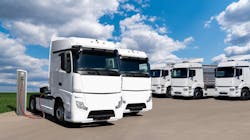EV steering components: Customized vs. off-the-shelf
The race to develop electric vehicles for the commercial vehicle market is moving rapidly. According to research from StartUs Insights, there are approximately 753 startups and emerging companies developing EVs, with 257 in the U.S. alone. Will the key players stick with conventional steering components in their vehicle design, or will they look for benefits in customization? Let's examines which way design engineers will steer.
Electric vehicles and their internal combustion engine (ICE) counterparts are quite similar in many respects, despite the obvious difference in their method of propulsion. When it comes to steering parts, the components you will find in a diesel van are usually the same as those you might find in a new electric van.
As a supplier of steering parts, when customers building electric vans or last mile delivery vans approach us, they usually ask for standard off-the-shelf parts. Although the components have usually been designed for an ICE vehicle, they will function just as effectively for electric vans.
However, there are benefits to customization and some engineers will want components that are purpose-built for their project. If an EV manufacturer designed and built their vehicle using standard parts, they might return and ask if the same part could be designed lighter. At this point, you now require a custom part.
See also: Twin steering conversions for commercial vehicles
Off-the-shelf versus customized
Customization comes with added costs, but for engineers looking to build lighter vehicles, custom parts have an advantage over traditional parts which are sometimes over-engineered. For those building electric vehicles and last mile delivery vehicles, weight reduction is often of paramount importance. Other benefits of customization include decreased size, which might be useful with a reduced space envelope, or alternative interface options, which allow the parts to marry better with other elements of the design or components related to the steering system.
If a component is engineered to carry a load of two tons, but it is being used for a small delivery van and will be subject to a load that is significantly lower than this, you can optimize the design to reduce the material in the component and therefore the weight.
However, the weight reduction that can be achieved through this optimization is quite minor, relative to the overall weight of the vehicle. For the time being, OEMs are therefore mainly focused on things like the material of the body as the quickest route to reducing the overall weight. Some manufacturers are building vehicles using composites for this purpose.
Looking further ahead, the demand for optimized opponents is likely to increase once weight reductions in other areas have been maximized. Once the low hanging fruit is gone, those extra grams gained from a custom bevel box begin to look a bit more juicy. Leading parts suppliers will begin to design and manufacture lighter components specifically for EVs and offer these as standard.
See also: Electrifying the final mile: What to consider
Steering the way to the future
Engineers at Pailton Engineering have been working on optimizing their components for electric vehicles. Fundamentally, the design of steering parts for commercial vehicles and heavy vehicles hasn’t changed significantly for many years. Options on the table are hollow shafts, thinner wall tubes or different materials for the yokes. With so many manufacturers looking to build lightweight delivery vans, we’ve decided to build a standard package, a system of generic steering parts, just for EVs.
As things currently stand, OEMs have to build their vehicles using larger, bulkier parts that are designed for different vehicles. If they do want customization, they will usually have to request this as a later stage in the process. In future, the availability of off-the-shelf parts that are specifically built for lighter vehicles may give them a headstart in this process.
Work on this is currently at a preliminary stage, with more than one option on the table. All the components are similar to what you would expect with traditional parts, but are optimized to reduce space and weight. The steering column, for example, has some features removed and is made from lighter components. It is smaller and lighter than your conventional column.
In developing components this way, a major challenge is the lack of agreement over what should be standard. We also need to factor in different driver positions, ensuring we meet all the adjustment rates. Finally, we must consider the ancillaries, such as the indicator switch, light switch and a smart steering wheel to link with a phone or radio.
As we are anticipating continuing demand for electric last mile delivery vehicles, we need to start designing and engineering with the future in mind, making sure that when tomorrow’s customers arrive, we are already on the road to the solutions they need.
We don’t know how any given technology will develop and a lot can change in a relatively short period of time. How many of those 753 startups will be making electric vehicles ten years from now? Although we don’t have answers to these questions, it is quite likely that EV makers will build their vehicles using different steering parts in future.
Pailton Engineering specialises in the design and manufacture of steering parts and full steering systems for commercial vehicles, including electric last mile delivery vehicles. To find out more, visit pailton.com
About the Author
Kostas Poulios
Kostas Poulios is the Principal Design and Development Engineer at steering system manufacturer Pailton Engineering.
